The history of Lignano
Records of
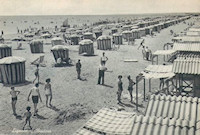 Lignano
previous to 15th April 1903 are only hardly enshrined in written documents, they
are rather embodied in the shapes of this tough territory and its landscapes, which
remained unchanged outside the main streams of history over the centuries. The only
few signs referring to Lignano are to be found on ancient maps, where it
is described merely as a physical existing piece of land, an "empty" area
between the "political" area belonging to the Republic of Venice and the ancient
fortress town of Marano, which represented the very last strategic defense line,
the outer border of the areas under the hegemony of the "Serenissima" (i.e. the
Republic of Venice). Between the Sixteenth and Seventeenth centuries the peninsula
of Lignano appeared for the first time on the accurate plans carefully drawn by
the so-called Water wise experts (Venetian magistracy appointed to guard the delicate
breath of the lagoon environment,
Lignano
previous to 15th April 1903 are only hardly enshrined in written documents, they
are rather embodied in the shapes of this tough territory and its landscapes, which
remained unchanged outside the main streams of history over the centuries. The only
few signs referring to Lignano are to be found on ancient maps, where it
is described merely as a physical existing piece of land, an "empty" area
between the "political" area belonging to the Republic of Venice and the ancient
fortress town of Marano, which represented the very last strategic defense line,
the outer border of the areas under the hegemony of the "Serenissima" (i.e. the
Republic of Venice). Between the Sixteenth and Seventeenth centuries the peninsula
of Lignano appeared for the first time on the accurate plans carefully drawn by
the so-called Water wise experts (Venetian magistracy appointed to guard the delicate
breath of the lagoon environment,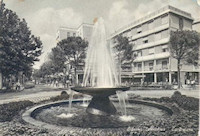 of vital interest for the "Serenissima"): 8 or
9 sets of dunes shaped by the winds, the tangled and moved net of canals, the sandy
stripe of beach resulting from the ancient weaving of the sea, the winds and of
the river Tagliamento. A thick wood of black-pines, holm-oaks, holly...a handful
of houses on the edge of a slight lagoon slope, some single "Casone", a fishers
shelter, and after 1500 a little church... A kind of "no man's
land" that should somehow give shelter to a handful of fishermen, raft-building
craftsman, farmers "whose faces bore clear signs of malaria", swamp and lagoon free
hunters, horse breeders; Those horses belonged to a wonderful horse breed and, according
to the tradition, they used to live free and wild in the pinewood as very well described
by the writer Elio Bartolini in a passage of a poetic writing of his: "Nearby the
beach surrounding the main mouth of the Tagliamento River, the horses are watered
until cooling before they run back to hide in the woods, the pleasure they get makes
them shake their manes and scourge their own flanks with their tails".
of vital interest for the "Serenissima"): 8 or
9 sets of dunes shaped by the winds, the tangled and moved net of canals, the sandy
stripe of beach resulting from the ancient weaving of the sea, the winds and of
the river Tagliamento. A thick wood of black-pines, holm-oaks, holly...a handful
of houses on the edge of a slight lagoon slope, some single "Casone", a fishers
shelter, and after 1500 a little church... A kind of "no man's
land" that should somehow give shelter to a handful of fishermen, raft-building
craftsman, farmers "whose faces bore clear signs of malaria", swamp and lagoon free
hunters, horse breeders; Those horses belonged to a wonderful horse breed and, according
to the tradition, they used to live free and wild in the pinewood as very well described
by the writer Elio Bartolini in a passage of a poetic writing of his: "Nearby the
beach surrounding the main mouth of the Tagliamento River, the horses are watered
until cooling before they run back to hide in the woods, the pleasure they get makes
them shake their manes and scourge their own flanks with their tails".
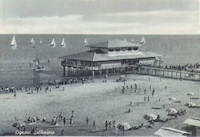 However,
the history of Lignano is embodied also, and perhaps much more meaningfully, in
its name - which bears the suffix "anum", thereby clearly proving the existence
of a human
settlement on the peninsula since the roman age. A written document dating back
to the V century reports of a "shore called Lignano", i.e. belonging to a man whose
name was Lunius. An estate not directly linked to the land nor to farming activities,
but rather -as argued by Luciano Bosio- aimed to providing the hinterland with everything
that sea and lagoon could offer, i.e. fish preservation, production of garum (a
peculiar fish sauce) and especially salt, which has always been an economic resource
of the utmost importance. A little wharf, which was connected with the lagoon lying
behind and with the hinterland plain through the many rivers flowing into the lagoon.
This territory was so rough that even the local tradition still maintains "Lignano"
to come from "Lupignanum": place infested with wolves, while the place name "Pineda"
is thought to mean "wood forest". Those woods usually arrived from "Carnia" (the
mountain area of the region), they were leaded along the Tagliamento river
However,
the history of Lignano is embodied also, and perhaps much more meaningfully, in
its name - which bears the suffix "anum", thereby clearly proving the existence
of a human
settlement on the peninsula since the roman age. A written document dating back
to the V century reports of a "shore called Lignano", i.e. belonging to a man whose
name was Lunius. An estate not directly linked to the land nor to farming activities,
but rather -as argued by Luciano Bosio- aimed to providing the hinterland with everything
that sea and lagoon could offer, i.e. fish preservation, production of garum (a
peculiar fish sauce) and especially salt, which has always been an economic resource
of the utmost importance. A little wharf, which was connected with the lagoon lying
behind and with the hinterland plain through the many rivers flowing into the lagoon.
This territory was so rough that even the local tradition still maintains "Lignano"
to come from "Lupignanum": place infested with wolves, while the place name "Pineda"
is thought to mean "wood forest". Those woods usually arrived from "Carnia" (the
mountain area of the region), they were leaded along the Tagliamento river
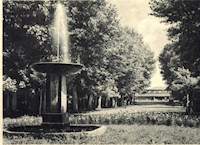 by
the "zatars", the old raft-drivers that steered trunks along the Tagliamento river
down to its mouth, where they were collected on venetian "trabaccoli" (a kind of
ship) and hence brought to the Venice arsenal, where wood was always badly needed
and it was brought there from all Venice possessions. In 1420 Lignano too
became part of the possessions of the Republic of Venice, which gave it over to
different noble families, as it was usual in the feudal system. Among these noble
families, the Vendramin Family, which was at that time dominating over Latisana
and descended from the "dogi" (the highest political authority within the Republic
of Venice), was the only one to bind tightly its name to Lignano by having the little
nice "Church of Saint Zachary" built right in the core of the tiny farmers'village
of Lignano Pineta, probably around the second half of the 16th century. This little
church, which actually marked the Vendramin's possession on Lignano, had not been
built for the almost
by
the "zatars", the old raft-drivers that steered trunks along the Tagliamento river
down to its mouth, where they were collected on venetian "trabaccoli" (a kind of
ship) and hence brought to the Venice arsenal, where wood was always badly needed
and it was brought there from all Venice possessions. In 1420 Lignano too
became part of the possessions of the Republic of Venice, which gave it over to
different noble families, as it was usual in the feudal system. Among these noble
families, the Vendramin Family, which was at that time dominating over Latisana
and descended from the "dogi" (the highest political authority within the Republic
of Venice), was the only one to bind tightly its name to Lignano by having the little
nice "Church of Saint Zachary" built right in the core of the tiny farmers'village
of Lignano Pineta, probably around the second half of the 16th century. This little
church, which actually marked the Vendramin's possession on Lignano, had not been
built for the almost 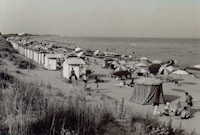 meaningless settled community (3"foci" - fireplaces, i.e. houses
in 1466; 2 houses, 8 people "aged enough to receive the Holy Communion" and some
children in 1648), but rather for the far more important group of fishermen and
boatmen who often stopped in this area. Actually,
the harbour of Lignano was strategically important as a key access in order to reach
by ship the sea area facing Marano which meanwhile had been transformed into a fortress
that was to become the keystone of Venetian supremacy on the Adriatic sea. Therefore,
only in connection with the far more important town of Marano, Lignano happened
to be mentioned in documents concerning medieval and modern history. After a long
series of skirmishes between Venice and the Habsburg Empire (in consequence
of which a little fortress had been built ad the edge of the peninsula in order
to protect the "harbour"), Lignano was not acknowledged within the Vendramin Family'possessions
any more, in
meaningless settled community (3"foci" - fireplaces, i.e. houses
in 1466; 2 houses, 8 people "aged enough to receive the Holy Communion" and some
children in 1648), but rather for the far more important group of fishermen and
boatmen who often stopped in this area. Actually,
the harbour of Lignano was strategically important as a key access in order to reach
by ship the sea area facing Marano which meanwhile had been transformed into a fortress
that was to become the keystone of Venetian supremacy on the Adriatic sea. Therefore,
only in connection with the far more important town of Marano, Lignano happened
to be mentioned in documents concerning medieval and modern history. After a long
series of skirmishes between Venice and the Habsburg Empire (in consequence
of which a little fortress had been built ad the edge of the peninsula in order
to protect the "harbour"), Lignano was not acknowledged within the Vendramin Family'possessions
any more, in
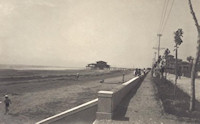 fact it became "Terra del Dogado", i.e. part of the military possessions
of the Republic of Venice, directly managed by the so called "Council of Ten". Meanwhile,
time passed in Lignano without leaving any significant sign, everything
but the seasons, that changed one after the other, remained the same. During the
Age of Napoleon a further little bunker was built to support the implementation
of the Continental Blockade against England in 1812. At the same time, all around
the little fortress of the "harbour Lignano" some people were settling down: in
1813 there were 70 inhabitants, among which police officers stationing in Lignano
and a sanitary supervisor. All this remained unchanged, like floating in time,
until the beginning of 20th century, when Lignano definitely committed itself to
tourist industry.
fact it became "Terra del Dogado", i.e. part of the military possessions
of the Republic of Venice, directly managed by the so called "Council of Ten". Meanwhile,
time passed in Lignano without leaving any significant sign, everything
but the seasons, that changed one after the other, remained the same. During the
Age of Napoleon a further little bunker was built to support the implementation
of the Continental Blockade against England in 1812. At the same time, all around
the little fortress of the "harbour Lignano" some people were settling down: in
1813 there were 70 inhabitants, among which police officers stationing in Lignano
and a sanitary supervisor. All this remained unchanged, like floating in time,
until the beginning of 20th century, when Lignano definitely committed itself to
tourist industry.